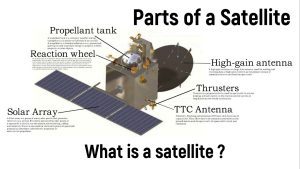Satellites are complex machines designed to perform specific tasks in space, from communication and navigation to scientific research and Earth observation. These tasks are made possible by various satellite components, each playing a critical role in ensuring the success of the mission. By understanding the components and their functions, one can appreciate the sophistication of modern satellite systems.

Key satellite components and their functions
Power systems
The power system is a vital component of a satellite, ensuring a steady energy supply for all onboard operations. Solar panels are commonly used to harness energy from the Sun, while batteries store this energy for use during eclipses or when sunlight is unavailable. The efficiency and reliability of the power system directly impact the satellite’s performance.
Attitude control systems
The attitude control system determines the satellite’s orientation in space. This system uses sensors, reaction wheels, and thrusters to maintain the correct position, ensuring that antennas, cameras, or other payloads are directed accurately. Precision in attitude control is crucial for tasks like imaging or data transmission.
Communication systems
Communication is one of the primary functions of most satellites, and the communication system facilitates data exchange between the satellite and ground stations. Antennas, transponders, and modems are integral components that enable signals to be sent and received over vast distances.
Payload
The payload refers to the specific equipment that fulfills the satellite’s mission objectives. For example, Earth observation satellites carry cameras or sensors, while communication satellites include transponders. The payload is often considered the heart of the satellite, as it determines its purpose.
Thermal control systems
Space presents extreme temperature variations, and thermal control systems protect satellites from these fluctuations. Components like heat pipes, radiators, and insulation maintain stable temperatures, ensuring that sensitive electronics and materials function optimally.
Onboard computers
Onboard computers are the central processing units of satellites, managing all operations and decision-making processes. They control navigation, data handling, and communication, ensuring the satellite performs as intended without requiring constant input from ground stations.
Propulsion systems
Propulsion systems are responsible for maneuvering satellites in space. They are used to adjust orbits, maintain positions, or deorbit at the end of a satellite’s lifecycle. Propulsion technologies range from chemical thrusters to advanced ion propulsion systems.
Structural components
The structure of a satellite provides the framework that holds all other components in place. It must withstand the stresses of launch while being lightweight to minimize costs. Modern satellites often use composite materials to achieve the necessary balance of strength and weight.
The importance of satellite components in mission success
Each component in a satellite is meticulously designed to meet the specific needs of its mission. The integration and performance of these components are critical to ensuring reliability and success. For instance, a failure in the power system could render the satellite inoperative, while inaccuracies in the attitude control system could lead to mission failure.
To achieve seamless operation, satellite manufacturers conduct rigorous testing of components under simulated space conditions. These tests include thermal vacuum testing, vibration analysis, and radiation exposure to ensure that all components perform as expected in the harsh environment of space.
Trends in satellite components
Miniaturization of components
As satellites become smaller and more cost-effective, there is a growing emphasis on miniaturizing components. Advances in materials science and electronics have enabled the development of compact, lightweight systems without compromising functionality.
Use of artificial intelligence
AI is increasingly being integrated into satellite components, particularly onboard computers. By enabling autonomous decision-making, AI allows satellites to respond to unexpected situations in real time, enhancing mission efficiency.
Modular designs
Many manufacturers are adopting modular designs for satellite components. This approach simplifies manufacturing, reduces costs, and allows for greater customization based on mission requirements.
Choosing high-quality satellite components
When developing or purchasing satellites, selecting reliable components is crucial. Working with trusted manufacturers and suppliers ensures that components meet the highest standards of quality and performance. Collaboration with experienced partners can also streamline the design and integration processes, contributing to overall mission success.
Satellite components are the foundation of every space mission. From powering the satellite to managing data and maintaining its position, these components work together seamlessly to achieve mission objectives. As the space industry continues to evolve, advancements in satellite components will play a pivotal role in shaping the future of space exploration and technology.
